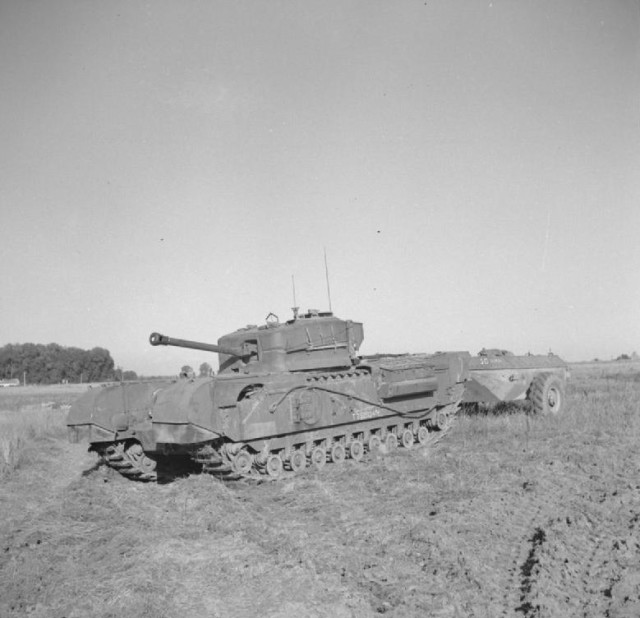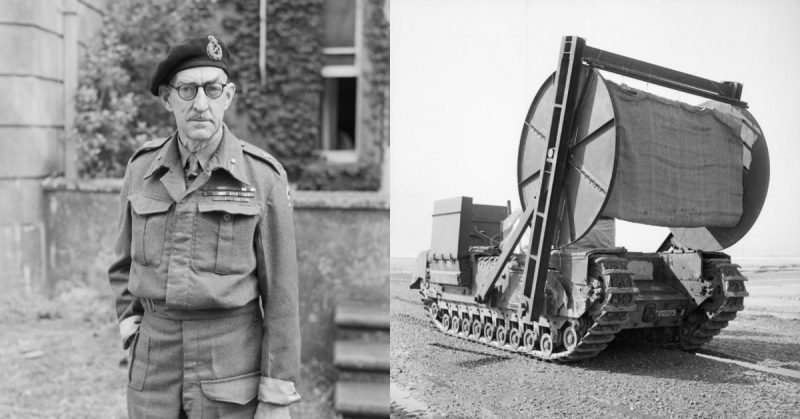‘Hobart’s Funnies’ were tanks, the brainchild creation of Percy Hobart, nicknamed ‘Hobo.’ In the end, they played a vital role in the success of the D-Day landings in 1944.
Percy Hobart, born in 1885 and schooled in England, was commissioned into the Corps of Royal Engineers in1904 after graduating from the Royal Military Academy in Woolwich. He served in WWI and during his service he became convinced of the growing importance of tanks in warfare. By 1934 he had become a respected expert on armoured warfare. He rose through the ranks, became Director of Military Training and was promoted to Major-General. He was passionate about tank warfare but had a reputation for being a difficult person to get on with. Hobart was put on ‘early retirement,’ on grounds of his age and ill-health.
The problems with conventional tanks were highlighted during August 1942, but it seemed that Hobart was the man with the solutions. A meeting between Hobart and Winston Churchill took place, after which Hobart was reinstated. He was given the task of improving Britain’s tank force. The 79th Armoured Division Royal Engineers, under his leadership, assembled and modified tanks which became known as ‘Hobart’s Funnies.’
Hobart used both the Sherman tank and the Churchill, creating highly specialised, weird-looking tanks that proved to be a major contributor to the success of the D-Day landings.

The first problem to be solved was how to land these heavy tanks on the beaches. Hobart had an extending canvas float screen and a propeller affixed to the Sherman DD ‘swimming tank.’ This allowed the carrier ships to stay out of firing range while ‘launching’ the tank which would then make its way (at 5mph) shore-wards! Once the Sherman DD tanks reached the beaches, the canvas screens were folded up, and the tank could be used conventionally.
To manoeuvre across the beaches, Hobart had tanks adjusted for travel over the sand. The Churchill Bobbin tank had a frontal mounting of a huge roll of canvas matting, which was unrolled to create a 200ft-long pathway for the tanks to drive on.
The beaches at Normandy were known to have extremely strong fortifications – but some of Hobart’s Funnies were prepared for that. The Sherman Crab had a flail in the form of a huge drum, housing spinning chains mounted in front. The impact of these spinning chains would detonate the mines, thereby clearing a safe path to follow.
To deal with the concrete fortifications a Churchill tank was modified to enable it to fire a dustbin-shaped mortar bomb weighing 40lb – at a rate that would shatter concrete. This tank, the Churchill AVRE, was specifically for blasting holes in concrete bunkers or the concrete walls.
Deep ditches and river crossings were dealt with by other modified Churchill tanks. The Churchill fascine carried huge bundles of sticks to place in ditches, enabling tanks to cross, and some of the Churchill tanks were modified to carry girder bridges which would be placed over water crossings.
The Churchill Ark was a tank did not have a turret; instead, it had ramps fitted over the front and the back and was used to allow other tanks to cross ditches or other obstacles.
Armoured bulldozers cleared pathways, removing rubble and wreckage and were also used to position demolition charges which could be detonated from a safe distance. There was also the Churchill Crocodile, which was a nasty, highly effective flamethrower.
After D-Day and for the duration of WWII, the “Funnies” were used extensively, deployed in smaller groups, when and wherever required. The 79th Armoured Division was soon the largest armoured unit in Europe, with a fleet of well over six thousand vehicles. After the war, on 20th August 1945, the 79th Armoured Division was disbanded. Today, more than seventy years after the end of WWII, most armies use specialist armoured vehicles that wouldn’t have looked at all strange beside those of Hobart’s “Funnies.”
By the time he finally retired in 1946, Hobart had received recognition for his contribution on many fronts. He had now become Major-General Sir Percy Cleghorn Stanley Hobart, KBE, CB, DSO, MC – a fitting list of accolades for such an out-of-the-box- thinker.
